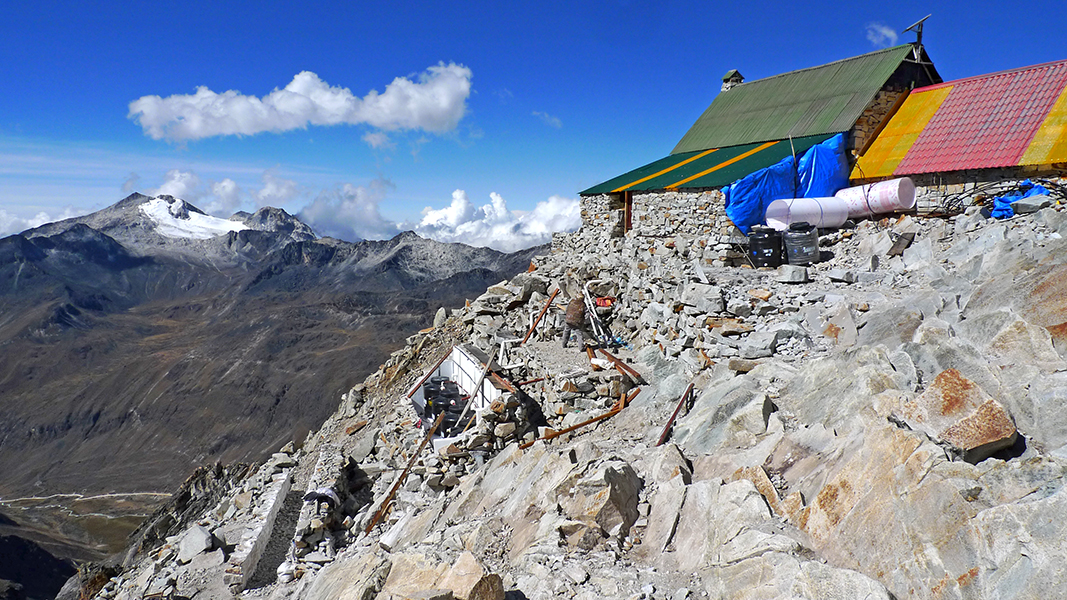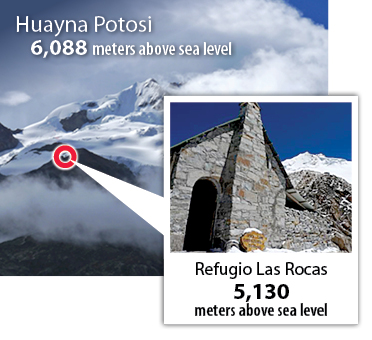Top: Refugio Las Rocas, home to a pilot digester project, is located on Huanya Potosi in Las Paz, Bolivia. See altitude details in graphic, below. Photos by J. Marti-Herrero.
Robin Szmidt and Embrey Bronstad
In Keep the Aspidistra Flying, George Orwell once wrote “It is not easy to make love in a cold climate when you have no money.” It turns out that cold-climate anaerobic digestion (AD) is not so easy either. The AD sector mostly seems to focus on one of three categories: European-style AD using industrial-scale stirred tanks that take food waste and yard trimmings, village-scale warm climate digestion, particularly in Asia, and then the general background of wastewater treatment. Of course, communities don’t always fit neatly into such groups.
In mid 2020, as part of its tribal trust responsibility to help Alaskan Native Villages with sanitation, the U.S. Environmental Protection Agency (EPA) began to look at the potential for use of AD in remote communities for both waste treatment and biogas generation. The EPA, in concert with Washington State University (WSU), spearheaded a think tank on aspects of AD specific to extreme cold and/or high latitude or altitude environments. Initial discussions (held virtually due to COVID) focused on the feasibility of implementing AD in rural Arctic and sub-Arctic communities that currently lack sufficient sanitation.
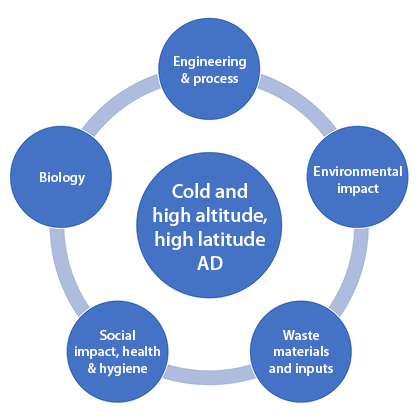 The scale and complexity of the issues around cold-community AD quickly became obvious: linking science, environment, society, geography and economics, as illustrated in the figure (see expanded version). This is a good reflection of the challenges of all research and development packages for fragile environments and locations. These interactions have since been encapsulated in the Arctic Research Plan 2022–2026.
The scale and complexity of the issues around cold-community AD quickly became obvious: linking science, environment, society, geography and economics, as illustrated in the figure (see expanded version). This is a good reflection of the challenges of all research and development packages for fragile environments and locations. These interactions have since been encapsulated in the Arctic Research Plan 2022–2026.
An unexpected result of the video forum in COVID times is that the original think tank group not only grew rapidly, but now has 25 members worldwide. While the group remains focused primarily on Alaska, the initiative struck a chord in respect to any challenging cold or high organic waste treatment situation worldwide. The group, now known as CHAD (Cold and High Anaerobic Digestion), is web-hosted by the Interagency Arctic Research Policy Committee (IARPC) collaborations’ website, which brings together stakeholders from federal, state, academic, nongovernmental (NGO), industry, Indigenous and international organizations. The broader international aspects easily relate to all of arctic North America and the north Atlantic, northern Europe, high-altitude regions of South America, and elsewhere.
Existing Sanitation Landscape
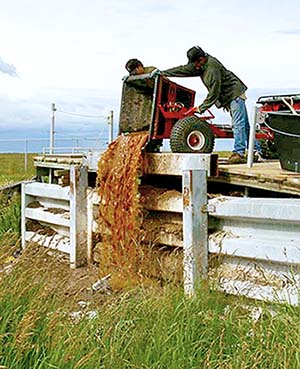
Urine and feces from “honey buckets” poured into a lagoon in Atmautluak, Alaska. Photo courtesy Alaska DEC
Even today in the 21st century, it may come as a surprise how many isolated communities are off-grid with little or no sanitation. Human waste may be collected in so-called “honey buckets,” a pail, usually lined with a nonbiodegradable plastic bag, used as a latrine in homes lacking indoor plumbing. The pails are taken mostly to open lagoons, usually with no treatment available and no easy or hygienic disposal method. More than 3,000 rural Alaskan households have to rely on honey buckets for human waste disposal. In cold regions, permafrost may make landfill of such material, and its contaminants, problematic or impossible, with little or no natural degradation or risk reduction. In arctic and sub-arctic conditions this also means an increased risk of water pollution, which is very difficult to avoid. And all this is in communities that often depend on near-surface fresh water and fishing.
At first glance, the situation might appear more transient and unimportant at high altitude. Isolated habitations tend to be scattered over large areas and trekkers and tourists seasonally come and go. However, in places such as Mount Everest, where hundreds of expedition climbers aim to achieve their life goals each year, there can be a big impact on fragile ecosystems. In particular, after decades of continued use and exploration, Everest Base Camp and the upper camps have become scarred by human impact. By 2019, human waste dumped in Gorak Shep, nestled in Mount Everest Sagarmāthā National Park, a UNESCO World Heritage Site, had grown to about 13 tons annually, causing ever-increasing environmental damage and posing severe risks to clean water sources. The name Gorak Shep translates as “Dead Crows” indicating that at over 5,000 m (about 16,400 ft), even birds might starve or freeze to death.
It is settings like these where CHAD can play a role in providing a solution. The Mount Everest Biogas project is developing local solutions for high-altitude organic waste management and is just one example of a project that can benefit from links to CHAD. Overall, about 10,000 houses at an altitude of more than 3,000 m could potentially benefit from micro AD in the rural Kathmandu region alone. Similarly in Bolivia, both tubular digesters and tank digesters have been successfully trialled above 5,000 m by members now associated with CHAD.
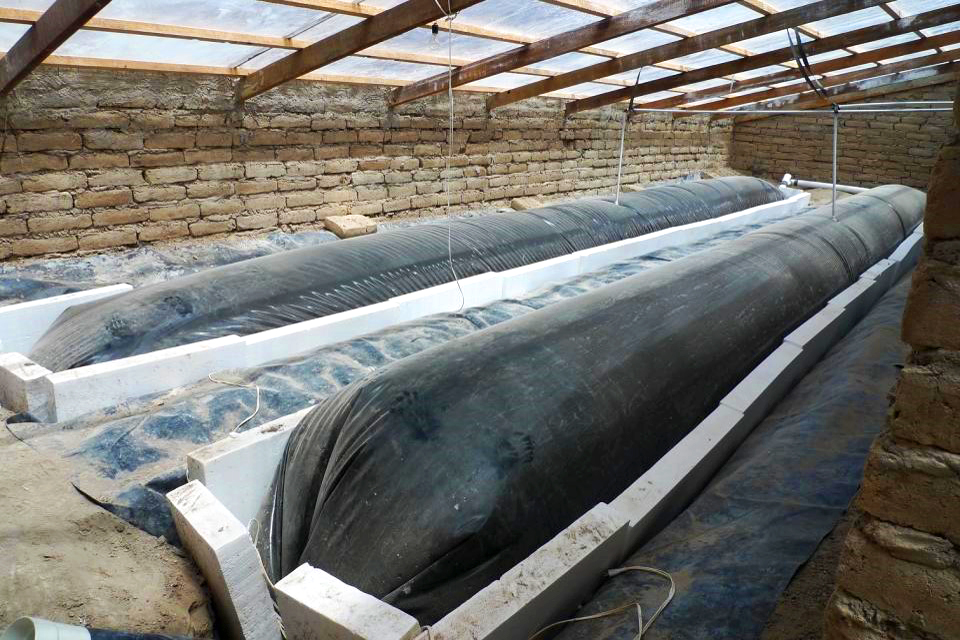
Tubular digesters within an insulated solar-collector structure in Bolivia. Photo by J. Marti-Herrero
Solutions That Fit The Setting
The CHAD group recognizes that it makes no sense to try and “parachute in” technical solutions using an urban, European-style, AD system. This approach to project development has always led to project failure in the past and increasing resistance to new-fangled technology by communities. The early concerns expressed in focus groups were cost, complexity and uncertainty (of technology). Alongside the technical search, CHAD is already committed to action on the ground with community group training and education, and identifying project “champions” right from the outset.
The key objectives of CHAD are to:
- Design and construct a digester using materials that are portable, simple, and readily available
- Minimize the ancillary equipment (pumps, etc.) associated with the digester in order to maximize simplicity and minimize operations and maintenance requirements
- Determine an appropriate enclosure, insulation and heating system that, to the extent possible, utilizes existing infrastructure, natural or local materials, and supplemental renewable energy if needed
- Conduct a thermodynamic analysis of the digester that assesses energy inputs relative to energy generated in order to determine whether a mesophilic or psychrophilic digester can produce energy in sufficient quantities to warrant its installation
- Monitor pathogen reduction, volatile solids reduction, and other waste stabilization characteristics of the digester in assessment of waste treatment capability
- Test the resilience of the digester microbiology to freezing
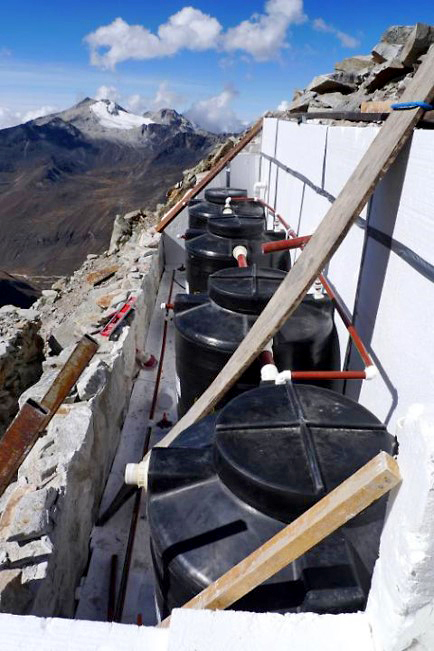
Challenges to cold and high altitude AD (example above at a pilot project in Bolivia) include establishing a productive biology in the system capable of functioning under extreme and variable conditions. Photo by J. Marti-Herrero
The group set about creating a knowledge base of the existing literature, which helped identify the key knowledge gaps. There are a number of challenges unique to cold and high latitude/altitude AD. Because of extreme seasonality and climate, feedstock availability will vary. Options to stockpile wastes in deep-freeze conditions and process them in digesters that start and stop needs research. The basic designs of tubular and tank digesters are both being considered. Tanks are more common worldwide but difficult to install below ground in extreme conditions. By contrast, tubular, or plug flow, designs need a different mix system and usually require bigger buildings. Insulation and mechanical parts must be effective, simple and easily maintained in remote locations, preferably using commonly available items such as motors and pumps. Finding power to run pumps needs off-grid solutions such as manual or wind-powered methods.
Although rural isolated communities worldwide are usually masters of mend-and-make-do, finding simple solutions to local problems, AD can only work in cold and high locations if the background science is right. Of particular concern is the establishment of a productive biology in the AD system capable of functioning under extreme and variable conditions. The CHAD group includes leading scientists researching psychrophilic microbial populations capable of usefully generating biogas at temperatures lower than 50oF (10oC). Post-AD digestate and researching its effect on fragile environments and ecosystems then becomes an essential part of the development project.
How To Participate
CHAD is not an exclusive club so if you have something to offer at any level, you’re welcome to contact the group. There’s an open invitation for CHAD participation, either generally or for specific topics, including aligning your existing R&D to the group objectives. CHAD is a professional, technical, group with a real chance of making a difference so companies and organizations, perhaps not directly working in AD, are invited to sponsor the group as part of their own corporate social responsibility and corporate citizenship commitments. By cosponsoring the group alongside other grant-support activities, CHAD can provide a high profile success story — on top of the world. To find out more about CHAD and how you can participate you can contact the authors: Robin Szmidt (Europe) or Embrey Bronstead (North America and rest-of-world).
Dr. Robin Szmidt is the founder and director of Target Renewables Ltd., a unique UK-based consultancy for the international AD sector. He has worked on a number of projects with major AD vendors and investors, in Europe and North America. He has a PhD in compost microbiology and a special interest in AD hygienization. He is an external lecturer at the University of Aberdeen (School of Engineering). Embrey Bronstad is a wastewater engineer at the Center for Sustaining Agriculture and Natural Resources (SANR) at Washington State University: College of Agricultural, Human, and Natural Resource Sciences (CAHNRS). She is a “waste”-to-resource evangelist with 15 years of engineering experience and IARPC “Cold/High Anaerobic Digestion Self-Formed Team” lead.


